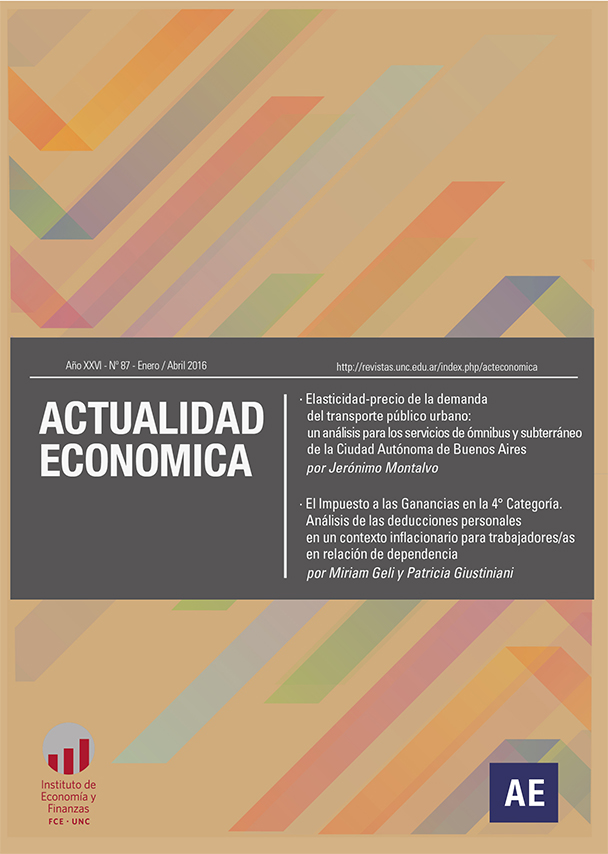Price elasticity of demand for urban public transport: An analysis for bus and underground services of the Autonomous City of Buenos Aires
Keywords:
Elasticity, demand, public transport, City of Buenos Aires.Abstract
This paper estimates the demand elasticity of two urban public transport services within the limits of the City of Buenos Aires, i.e., underground subway services and buses whose entire route runs within the boundaries of the city. I use a monthly database from 1993 until 2013 and, by using two different methodologies –dynamic models and cointegration and error correction models–, different regressions are analyzed to find the short and long-term coefficients, with particular emphasis on price-elasticities of the two demands. Consistent with the literature review, I find inelastic demands with long-term coefficients higher than short ones. In the case of the subway, where more explanatory variables are available, both econometric methods generate negative own price-elasticities between 0.1 and 0.2. Meanwhile, regarding buses, where the estimation is more difficult, the demand reacts more slowly to changes in prices, which is shown by larger differences between short and long-term estimates, even though the latter are close to what international experience shows (-0.5).
Downloads
References
Balcombe, R., Mackett, R., Paulley, N., Preston, J., Shires, J., Titheridge, H., Wardman, M. y White, P. (2004). “The demand for public transport: a practical guide”. Transport Research Laboratory, Report TRL593.
Boilard, F. (2011). “La demande de l´essence au Canada. Analyse de la stabilité de l´élasticité-prix et revenu sur le période 1970-2009”. Département d´économique. Faculté des sciences sociales. Université Laval.
Dargay, J.M. y Hanly, M. (2002). ”The demand for local bus services in England”. Journal of Transport Economics and Policy, 36 (1). pp. 73-91.
García, M. (2002). “Una aproximación microeconómica a los determinantes de la elección del modo de transporte”.
Gschwender, A. y Jara-Díaz, S.R. (2007). “Elasticidades de la demanda del transporte público urbano: síntesis e interrelaciones”. XIII Congreso Chileno de Ingeniería de Transporte, Santiago. Departamento de ingeniería civil. Universidad de Chile.
Gines de Rus, M. (1990). “Public transport elasticities in Spain”. Journal of Transport Economics and Policy. University of Leeds.
Girardotti, L.M. (2003). “Economía del transporte. Función económica del transporte”. Departamento de transporte. Facultad de Ingeniería. Universidad de Buenos Aires.
Goodwin, P.B. (1992). “A review of new demand elasticities with special reference to short and long run effects of price changes”. Journal of Transport Economics and Policy. Vol. 26, No. 2, pp. 155-169.
Islas Rivera, V., Rivera Trujillo, C. y Torres Vargas, G. (2002). “Estudio de la demanda de transporte”. Secretaría de comunicaciones y transportes. Instituto mexicano del transporte. Publicación técnica n° 213.
Liendro, N. (2013). “Determinantes de la demanda de transporte: una comparación entre Salta y Posadas”. XLVIII Reunión Anual Asociación Argentina de Economía Política. Instituto de Investigaciones Económicas Universidad Nacional de Salta (UNSa).
Litman, T. (2004). “Transit Price Elasticities and Cross-Elasticities”. Victoria Transport Policy Institute. Journal of Public Transportation, Vol. 7, No. 2, pp 37-58.
Litman, T. (2013). “Transport Elasticities: Impacts on Travel Behaviour”. Victoria Transport Policy Institute. Sustanaible Urban Transport Technical Document.
Litman, T. (2013). “Undestanding Transport Demands and Elasticities”. Victoria Transport Policy Institute.
Matas, A. (1991). “La demanda del transporte urbano: un análisis de las elasticidades y valoraciones del tiempo”. Universidad Autónoma de Barcelona. Investigaciones Económicas (Segunda época). Vol. XV, n°2, pp. 249-267.
Muller, A. (2013). “El transporte de la Región Metropolitana de Buenos Aires: ¿hacia el ‘colapso’?”. Facultad de Ciencias Económicas. Universidad de Buenos Aires. Centro de Estudios de la Situación y Perspectivas de la Argentina.
Neumeyer, A., Cepellotti, A., Jenik, E., Santaella, G. y Vernhes, G. (2013). “Evolución y evaluación del transporte público en el área de Buenos Aires: 1960-2013. Congestión y deterioro”. Universidad Torcuato Di Tella. XLVIII Reunión Anual Asociación Argentina de Economía Política.
Oum, T.H., Waters, W. y Yong, J. (1992). “Concepts of price elasticities of transport demand and recent empirical estimates”. Journal of Transport Economics and Policy. Vol. 26, No. 2, pp. 139-154.
Pham, L.H. y Linsalata, J. (1991). “Effects of fare changes on bus ridership”. American Public Transport Asociation, Research and Statistics division.
Reta, C.E. (2006). “Determinantes socioeconómicos de la demanda de transporte urbano en el Gran Mendoza. Encuesta Origen-Destino 2005”. Facultad de Ciencias Económicas. Universidad Nacional de Cuyo.
Sartori, Juan J. P. (2003). “Estimación de elasticidades de demanda para el transporte urbano de pasajeros de la ciudad de Córdoba (Argentina)”. XXXVIII Reunión Anual de la Asociación Argentina de Economía Política, Mendoza.
Wardman, M. y Shires, J.D. (2003). “Review of the fare elasticities in Great Britain”. Institute of Transport Studies. U niversity of Leeds. UK.
Downloads
Published
Issue
Section
License
Those authors who have published with this journal, accept the following terms:
Authors will conserve their copyright and guarantee the magazine the right of first publication of their work, which will be simultaneously subject to the Creative Commons Attribution-NonCommercial-NoDerivative 4.0 International License that allows third parties to share the work as long as the author and first publication of this magazine are indicated.
Authors may adopt other non-exclusive license agreements to distribute the published version of the work (e.g., deposit it in an institutional telematic archive or publish it in a monographic volume) provided that the initial publication in this journal is indicated.
Authors are allowed and encouraged to disseminate their work through the Internet (e.g., in institutional telematic archives or on their website) before and during the submission process, which may lead to interesting exchanges and increase citations of the published work. (See The effect of open access)









